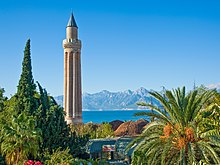| Yivli Minaret Mosque | |
|---|---|
 | |
| Religion | |
| Affiliation | Islam |
| Location | |
| Location | Antalya, Turkey |
| Architecture | |
| Type | Mosque |
| Style | Seljuk |
| Completed | 1230/1373 |
| Specifications | |
| Minaret height | 38 m |
| Materials | stone, brick |
The Yivli Minaret Mosque (Turkish: Yivliminare Camii; lit. "Fluted Minaret" Mosque), also known as the Alaaddin Mosque (Turkish: Alaaddin Camii) or simply Grand Mosque (Turkish: Ulu Camii), in Antalya is a historical mosque built by the Anatolian Seljuk Sultan Kayqubad I. It is part of a külliye (complex of structures) which includes the Gıyaseddin Keyhüsrev Medrese, Seljuk and Dervish lodge, and the vaults of Zincirkıran and Nigar Hatun. The mosque is located in Kaleiçi (the old town centre) along Cumhuriyet Caddesi, next to Kalekapısı Meydanı. The mosque's fluted minaret called the Yivli Minare, which is decorated with dark blue tiles, is a landmark and symbol of the city. In 2016 it was inscribed in the Tentative list of World Heritage Sites in Turkey.
History
The mosque was first built in 1230 and fully reconstructed for the second time in 1373. The minaret is 38 metres (125 ft) high and free-standing, built on a square stone base, with eight fluted sections and has 90 steps to the top.
The first building (1230) was built around 1225-7, during the reign of the Seljuk sultan Ala ad-Din Kay Qubadh I (1220–1237). The original mosque was destroyed in the 14th century and a new mosque was built in 1373 by the Hamidids on the foundation of a Byzantine church. With its six domes, it is one of the oldest examples of multi-dome construction in Anatolia.
Today the building houses the Antalya Ethnographic Museum and contains clothing, kitchen utensils, embroidery, tapestries and looms, socks, sacks, kilims, ornaments, and nomadic tents. It was opened to the public in 1974.
See also
Notes
- ^ Ring, Watson & Schellinger 1995, p. 38.
- "Yivli Minaret Mosque". UNESCO World Heritage Centre. UNESCO. Retrieved 13 June 2018.
- Hillenbrand 1994, p. 163.
- Crane 1993, p. 8.
- Bloom & Blair 2009, p. 142.
References
- Bloom, Jonathan; Blair, Sheila, eds. (2009). "Architecture". Grove Encyclopedia of Islamic Art & Architecture. Vol. 1. Oxford University Press.
- Crane, H. (1993). "Notes on Saldjūq Architectural Patronage in Thirteenth Century Anatolia". Journal of the Economic and Social History of the Orient. 36 (1): 1–57. doi:10.1163/156852093X00010.
- Hillenbrand, Robert (1994). Islamic Architecture: Form, Function, and Meaning. Columbia University Press.163
- Ring, Trudy; Watson, Noelle; Schellinger, Paul, eds. (1995). Southern Europe: International Dictionary of Historic Places. Vol. 3. Fitzroy Dearborn Publishers.
External links
36°53′11″N 30°42′16″E / 36.88639°N 30.70444°E / 36.88639; 30.70444
Categories:- Anatolian Beyliks architecture
- Tourist attractions in Antalya
- History of Antalya Province
- Mosques in Antalya
- Muratpaşa District
- Buildings and structures completed in 1373
- Mosques completed in the 1370s
- World Heritage Tentative List for Turkey
- Buildings and structures completed in 1230
- Mosques completed in the 1230s
- History of Antalya